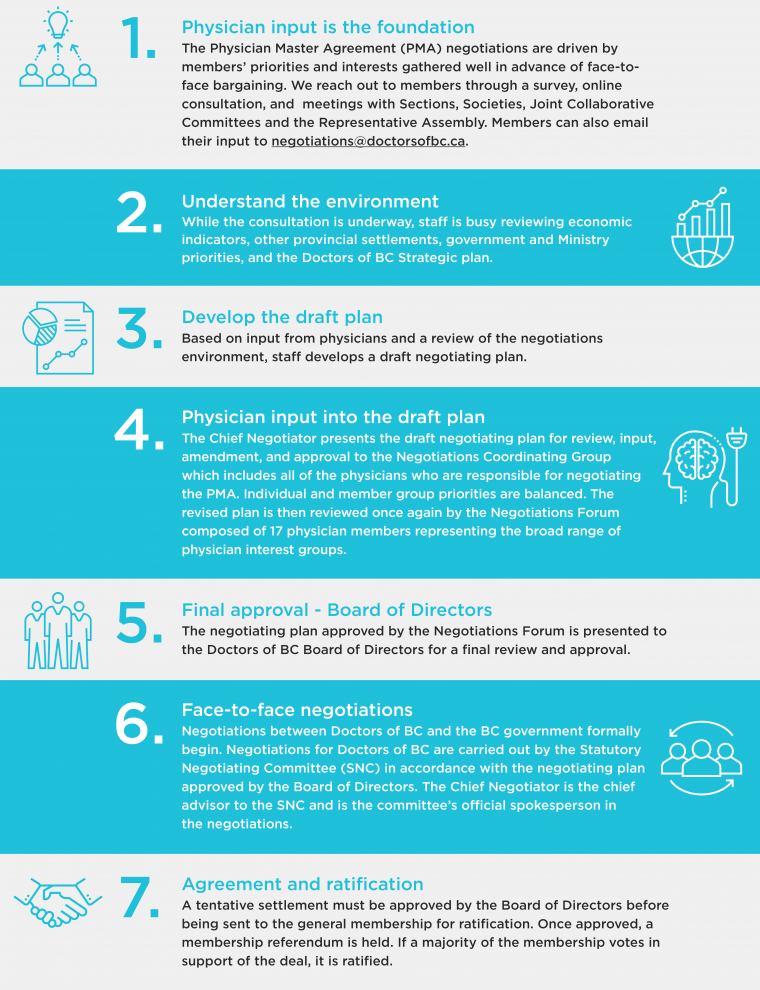- Managing your Practice
-
- Your Benefits
-

Introducing the ultimate Club MD experience
From work to play, and everything in between, we provide you with access to hundreds of deals from recognizable, best-in-class brands, elevating every facet of your life – from practice supports to entertainment, restaurants, electronics, travel, health and wellness, and more. Your Club MD membership ensures that these deals are exclusive to you, eliminating the need to search or negotiate.
Welcome to the ultimate Club MD experience. Your membership, your choices, your journey.
-
- Advocacy & Policy
-
- Collaboration
- News & Events
-

Stay Informed
Stay up to date with important information that impacts the profession and your practice. Doctors of BC provides a range of newsletters that target areas of interest to you.
Subscribe to the President's Letter
Subscribe to Newsletters
-
- About Us
-
Physician Master Agreement - How Negotiations Works
May 6, 2019
News
Members often ask us “how do negotiations work”? We have prepared the following information to provide an overview of the process, highlighting the importance of the physician voice in the development of the negotiating mandate and in the bargaining.
Often people think that the actual bargaining period is when negotiations start, and that is not the case. The process begins well before that, and the important work done in preparation for bargaining is critical to achieving success.
The information below provides an overview of the key steps and milestones in developing the mandate for negotiations, the bargaining, and how an agreement is approved by members. Do you have questions or suggestions after reading the article? E-mail us at

Detailed information on negotiations process
1. Physician input is the foundation
PMA negotiations are driven by members’ priorities and interests. Doctors of BC starts its work well in advance of face-to-face bargaining. We gather extensive input from physicians in many different ways so that we fully understand the membership’s key priorities and concerns. For example, in our negotiations for the 2019 PMA, we consulted through:
-
President’s letter seeking input from every physician.
-
A comprehensive survey of members regarding their PMA negotiations priorities.
-
Meetings with all sections and both societies.
-
Meetings with DoBC representatives from GPSC, SSC, SCC, Joint Benefits Committee
-
Input from the Representative Assembly.
-
Online consultations with members.
All of the feedback from members is collected and analyzed to find recurring themes and priority areas.
2. Understanding the environment
While the consultation is underway, staff is busy reviewing the negotiations environment, taking into consideration factors that can impact negotiations. These include: economic indicators, other provincial settlements, government and Ministry priorities, and the Doctors of BC Strategic plan.
3. Developing the plan
Once we’ve obtained physician input and assessed the negotiating environment, Doctors of BC staff work together to develop a draft negotiating plan for review by the physician committees that have the responsibility to recommend the plan to the Board of Directors.
4. Physician input into the draft plan
Once the draft negotiating plan is prepared, it is reviewed by two internal Doctors of BC Committees, also made up of physicians. This is done to ensure that it represents the interests of all physicians in BC. This requires a balancing of the priorities of individual member groups.
The Chief Negotiator presents the draft negotiating plan for review, input, amendment, and approval to the following committees:
-
Negotiations Coordinating Group (NCG), composed of the Statutory Negotiating Committee and one nominee from each of the following groups:
-
Negotiations Forum (NF), composed of 16 representatives representing the broad range of physician interest groups. Its primary objective is to review the negotiating plan and strategy from a broader membership perspective and to make a recommendation to the Board.
5. Final approval - Board of Directors
Once the draft negotiating plan is endorsed by the Negotiations Forum, it is presented to the Doctors of BC Board of Directors. Approval by the Board constitutes direction to the SNC to formally begin negotiations with the BC government.
6. Face-to-face negotiations
Now negotiations between Doctors of BC and the BC government can formally begin. Negotiations for Doctors of BC are carried out by the SNC. It’s primary responsibility in this phase is to lead on PMA negotiations in accordance with the negotiating plan approved by the Board of Directors. The Chief Negotiator is the chief advisor to the SNC and is the committee’s official spokesperson in the negotiations.
The government and Doctors of BC generally agree to a communications/media blackout during the period of face-to-face negotiations so that each side can explore the broadest range of options to find a deal that represents both parties best interests. This is a common practice in almost all negotiations.
7. Agreement and ratification
Once the partners reach a tentative settlement, the following steps are taken:
-
Board of Directors: Reviews and must approve the tentative settlement. Board approval constitutes direction that the tentative settlement be distributed to the general membership for ratification
-
Membership Referendum: A summary of the tentative settlement and the detailed changes to the PMA are distributed to the general membership for consideration in the ratification vote.
-
Ratification vote period - Members are given 3 to 5 weeks to review the material and to vote on whether to accept the changes.
-
If a majority of the membership votes in support of the deal, it is ratified and the agreement is signed by all parties.
Do you have questions about the negotiations process? E-mail us at
Are you receiving President’s Letters and our In Circulation Newsletter? If not, you may be missing important information on negotiations and other important Association news that impacts you and your practice. Click on the links to subscribe.




